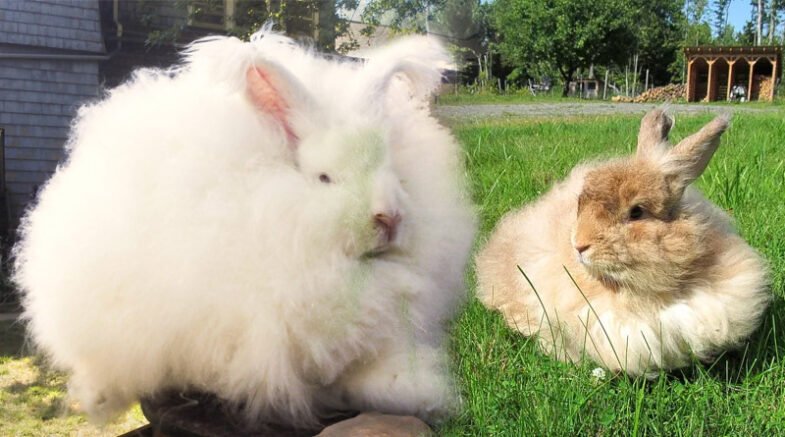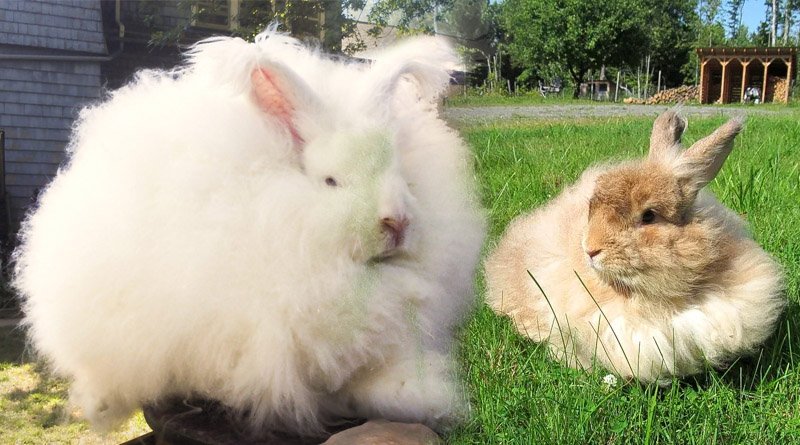Rabbits grow very fast, which increases their economic status. Their meat is high in protein and naturally reduces cholesterol.

After rearing and breeding, Angora rabbits are being distributed to the people at rural level in Mansehra and Abbottabad in collaboration with local NGO Sungi Development Foundation.
Humans have been rearing rabbits for centuries. Rabbits grow very fast, which increases their economic status. Their meat is high in protein and naturally reduces cholesterol. It is very beneficial for human health. Its wool is of very high quality and very valuable. Rabbits are small and beautiful animals that are bred for meat, wool, and fur.
In the 19th century AD, rabbit breeding became very popular and rabbits were kept in cages. In 1920, rabbit fur became very popular among people and it was started to breed for obtaining fur. In 1994, three million rabbits were bred in the United States and at the same time, scientific research centers were established to breed them to improve their color and fur.
In 1994, the rabbit was the second animal in the world to be successfully asexually cloned. Today, rabbits are bred all over the world, including France, Germany, Australia, Great Britain, China, New Zealand, India, Nepal and other countries. And now Pakistan will also join these countries.
Angora:
Government of Khyber Pakhtunkhwa has built a model Angora rabbit farm in Mansehra District Livestock Experiment Jaba, a subsidiary of Livestock and Dairy Development KPK in the province and brought Angora rabbits from Pakistan Agricultural Research Council Islamabad, which are imported from Nepal. Angora rabbit farm is a development project of rearing and expansion in the province.
After rearing and breeding, Angora rabbits are being distributed to the people at rural level in Mansehra and Abbottabad in collaboration with local NGO Sungi Development Foundation. Women will be given priority for this work so that people can get a good job and source of employment at the local level.
Due to which the quality of life of the poor and impoverished families will improve due to the increase in their income. And especially Angora rabbit farming will be a reasonable source of income for the women staying at home. Due to which, along with income, confidence will also increase among skilled women.
This type of rabbit is popular all over the world because of its shiny, soft and attractive wool. They belong to an ancient race. Angora originated from Angora province of Turkey in Asia. A consistent climate is best for angora rabbits. They cannot tolerate heat because they do not have sweat glands.
In the cold season and before giving birth, add dry grass and cotton to keep the nest of Angora rabbit warm so that its temperature remains normal. Angora mother has her own special smell and her children also have the same smell by which she recognizes her children. If Angora rabbit is kept in cages, their lifespan will be five to seven years, and if they are kept in an open place, their lifespan will be reduced.
Types:
At present, there are many varieties of Angora rabbits around the world. It includes English Angora, French Angora, Giant Angora, Satin Angora, California Angora, White Angora, New Zealand Angora, Russian Angora, and Chanchala Angora.
The Wool of Angora:
Angora wool is six times warmer than all other types of wool and is relatively soft and silky. Thus, it is perfect for the needs of cold regions. Items made from angora wool are unmatched and very expensive due to their light weight, warmth, and beauty.
Housing cages:
Since the Angora rabbit is bred for wool, it is important to keep it clean in the barn so that its wool does not spoil. The Angora cage should be kept in a clean and open place, the sick Angora should be separated from the healthy Angora and the cage should be cleaned every week to avoid germs.
There are two types of cages for rabbits. Living cages and nesting boxes of baby size. For an adult rabbit over six weeks of age, 2x2x2 feet (height, length and width) are available. Which are adequate for housing purposes but when the female rabbit becomes pregnant, they are shifted/transferred to nesting cages in the third week of pregnancy.
Because they have to give birth to children in this cage, the number of which can be up to 4-10 children. Therefore, this is their living size (2x2x2+2x3x2 feet). These types of cages are called nesting cages. In them, the babies can stay with their mother for six weeks, after which they are also transferred to separate cages.
Best Habitat and Housing for Angora:
Angora should be housed in a place with adequate ventilation and light. Angora should also be kept away from unnecessary noise. 15 to 20oC is the best temperature for Angora, while they can withstand temperature in a wide range from 5 to 30oC.
Nourishment/Diet:
Angora rabbits need to be fed a well-balanced diet and a three-time feeding schedule is essential. Angora’s diet includes water minerals, fats and starches, vitamins and minerals, which are corn, oats, buckwheat, sorghum, cow dung, green grass, lucerne, various vegetables, alfalfa, dry natural grass, cow hay, hydrangea.
Special vanda, corn hearts, etc. made for them are given to Nick Fader. An additional 100 grams of Vanda is given daily to a rabbit and 140 grams of Vanda to a pregnant rabbit until the babies are weaned.
Fertility and Pregnancy:
Male and female rabbits need a few minutes to mate. After mating, the male and female are separated. Each pregnancy lasts for 29 days, after which the female can give birth to 1-10 children and breastfeed the children for a few weeks. Newborn babies open their eyes after 16 days.
After 6-8 weeks, the cubs are separated from the mother and kept in separate housing cages. The female gives birth three to four times in a year. Wool production Angora rabbits should shed their wool after three to four months in a year. A rabbit produces an average of 800-1200 grams of wool per year.
Cleaning of wool:
As soon as the Angora’s wool grows, start grooming it with a soft-toothed brush. The shedding stage of Angora wool is the most important. The wool is shed after every three months when the wool becomes eight to twelve centimeters long. The wool is then turned into hair which is no longer usable – put the wool in a plastic bag and secure it with phenyl tablets in the cross.
Diseases and Prevention:
- Ear canker is very common in rabbits, which is caused by wet urine. Therefore, the Angora cages should be kept well cleaned.
- Angora also suffers from stomach problem. Due to which his stool becomes thin and he eats less, this disease is called coccidiosis. For this, it is better to consult a doctor or give half a pill of human children’s use, then it will be fine.
- Skin disease is also common in it, in which its wool falls off. For this, put it in lukewarm water and rub it well on the rabbit’s body for 10-15 minutes and wash it with lukewarm water.
- Water starts coming out of the Angora’s eye (weepy eye) and the area around the eye becomes sore. In this case, give foods that are high in vitamin A (carrots and green fodder).
- Angora pneumonia is caused by cutting hair in winter. In such a case, keep it in a warm place.
- Grapes get fur block i.e.; the small intestine gets blocked due to fur which can be cured by eating hard grass and bamboo.
- Scabies in rabbits due to wool can be caused by fleas, lice and maggots. Treat them with the advice of a veterinary doctor.
- In case of illness, it would be better to consult a veterinary doctor
- Angora rabbit food and water should be of high quality, mold and mildew free
- Do not use tomatoes in the diet of Angora rabbits. Tomatoes will increase the death rate.
Prominent Benefits of Angora Rabbits:
- Angora rabbit farming is easy and can be started with low investment and can be expanded from household level to commercial farming and can provide good employment and increase income at the local level.
- A female rabbit can give birth to 20 to 50 litters in a year and can contribute to the country’s increase in wool and meat production.
- The wool of the Angora rabbit is very valuable and comes in a variety of colors, but the white wool is the most valuable.
- Its meat is low in fat and also low in cholesterol which is considered good for heart patients.
- Angora urine makes excellent manure.
- Angora fur makes excellent leather jackets, hats, bags and other accessories.
- Angora yarn is used to make the yarn used in the operation.
This article is jointly authored by Razia Kausar, Muhammad Abdullah, Urfa Bin Tahir from Department of Parasitology and Shah Nawaz, Aitzaz Khalid from Department of Anatomy, Faculty of veterinary Science, UAF.
